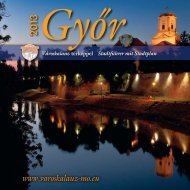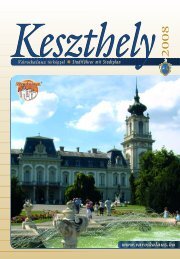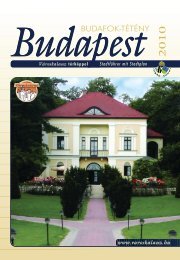2011 KISPEST - Városkalauz
2011 KISPEST - Városkalauz
2011 KISPEST - Városkalauz
Create successful ePaper yourself
Turn your PDF publications into a flip-book with our unique Google optimized e-Paper software.
A kerület múltja és jelene � The District's past and present<br />
Traditions and modernisation<br />
In the fi rst written documents (1869) about Kispest the town was listed as ‘Colonie Klein Pest’. Since 1723<br />
the area belonged to the lordship of Gödöllô, to the property of the Grassalkovich noble family. According to<br />
the earliest maps of the area, today’s Kispest was an uninhabited, not really valuable agricultural area. After<br />
the extinction of the Grassalkovich family the property changed hands several times, and in 1864 it became<br />
the property of Banque de Crédit Fonciére et Industrielle. At fi rst, the fi nancial institution, headquartered in<br />
Belgium, planned to establish a model farm, however, they soon realised that their plans are not really profi table.<br />
Therefore they sold the area, containing wetlands and reed beds, separated into 50-100-500-acre parcels.<br />
Although the new owners had to take into<br />
consideration the problems caused by the<br />
groundwater, they could be sure that because<br />
of the short distance to Pest, their properties will<br />
preserve their value on the long term. Some of<br />
them planned to establish a holiday site here,<br />
others were thinking about utilising the area for<br />
hunters and fishermen. Those who were speculating<br />
about preserving the value of the land, made<br />
a good choice as already at the beginning of<br />
1870’s one could know that by the union of Pest,<br />
Buda and Óbuda the new capital city of the<br />
country is soon to be created, and the economic<br />
significance of the area along Üllôi country road,<br />
lying only 9-10 kilometres from the centre of Pest,<br />
as a suburb, may increase a lot.<br />
� This meant that all those who had previously<br />
purchased a larger-size property here, could count<br />
Hôsök szobra – Hybl József alkotása<br />
Statue of heroes – Artwork by József Hybl<br />
Kossuth tér a Kossuth-szoborral<br />
Kossuth Square with the statue of Kossuth<br />
on receiving a substantial revenue from the separation<br />
of their properties into smaller parcels. It<br />
was not by chance that the separation of the land<br />
located closer to the border of Pest was carried out<br />
only after the foundation of the town. In 1869<br />
there were altogether 361 houses built on the<br />
area, and in 1871 its inhabitants applied for the<br />
title of a temporary smaller town. In 1872 the<br />
social transport service was started, reaching the<br />
final stop of the horse railway line of Pest, this way<br />
making accessible the workplaces of Pest and<br />
Kôbánya. However, the foundation of holiday<br />
places of Southern Pest was soon cancelled.<br />
� Since 1873 Kispest had been showing a rapid<br />
development, in 1874 it received a title of a big<br />
town, and till 1909 beyond its today’s areas it<br />
encorporated also Pestszentlôrinc. The number of<br />
inhabitants had been increasing continuously,<br />
together with the number of residential buildings.<br />
Those who purchased parcels here were led by the<br />
<strong>Városkalauz</strong> � Budapest, Kispest <strong>2011</strong> 5






